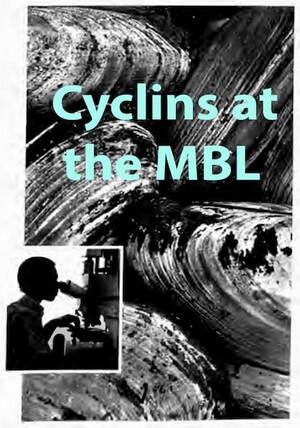The Marine Biological Laboratory has a long history with work on the cell cycle and its related processes and molecules. Marine species are chosen for much work in development and genetics due to the large amounts of eggs, sperm, and embryos they produce, the level at which we understand their DNA, and (for much of the early time at the MBL) their accessibility. arine species - like surf clams (Spisula solidissima) and sea urchins (Arbacia punctulata) - have helped researchers at the MBL discover and determine the function of cyclins (proteins that control the cell cycle), outline much of the cell cycle, and also determine some of the genetics behind how cells grow and divide.
Work on cell cycle regulation at the MBL began in 1979 in the lab of Joan Ruderman and continued with the discovery of cyclins by Tim Hunt in 1982. In the years following, MBL investigators like Marc Kirschner and John Gerhart contributed further to our understanding of the beginning of the cell cycle, and in 1991, MBL visitor Avram Hershko explained the end of the cell cycle and the degradation of cyclins.
What are Cyclins?
- Branden, C. I. (1999). Introduction to Protein Structure. New York: Garland Science. - https://books.google.com/books?id=eUYWBAAAQBAJ&pg=PA107&lpg=PA107&dq=domain+structure+of+cyclins&source=bl&ots=Pz5XNBd3kZ&sig=n2O3Cw0Vr8GmvuV0y-KF6i0PfYw&hl=en&sa=X&ei=BQl3VfOqMu-HsQTY5YOwDQ&ved=0CGIQ6AEwCw#v=onepage&q=domain%20structure%20of%20cyclins&f=false
- Hershko, A. (1999). Mechanisms and regulation of the degradation of cyclin B. Philosophical Transactions of the Royal Society B: Biological Sciences, 354(1389), 1571-1576.
- Nobel Prize, 2001. http://www.nobelprize.org/nobel_prizes/medicine/laureates/2001/hunt-bio.html
Early Work with Cyclins
- Boveri, T. (1902). On multipolar mitosis as a means of analysis of the cell nucleus. Foundations of experimental embryology, 1964, 74-97.
- Franz, S. (2002). http://www.nature.com/celldivision/milestones/full/milestone02.html
- Greaves, S. (2002). http://www.nature.com/celldivision/milestones/full/milestone07.html
- Jackson, P.K. (2008). The Hunt for Cyclin. Cell, 134, 199-202
- MBL History Project. "Joan Ruderman Cyclin Research I." Filmed June 2015. MBL History Project Video, 5:58. Posted June 2015. http://history.archives.mbl.edu/node/16066.
- MBL History Project. "Joan Ruderman Cyclin Research II." Filmed June 2015. MBL History Project Video, 8:55. Posted June 2015. http://history.archives.mbl.edu/content/joan-ruderman-cyclin-research-ii-june-5-2015.
- Mitchell, A. (2002). http://www.nature.com/celldivision/milestones/full/milestone03.html
- Nath, D. (2002). http://www.nature.com/celldivision/milestones/full/milestone06.html
- Patterson, M. (2002). http://www.nature.com/celldivision/milestones/full/milestone05.html
- Rosenthal, E. T., Hunt, T., & Ruderman, J. V. (1980). Selective translation of mRNA controls the pattern of protein synthesis during early development of the surf clam, Spisula solidissima. Cell, 20(2), 487-494.
- Surridge, C. (2002). http://www.nature.com/celldivision/milestones/full/milestone01.html
Tim Hunt and His Discovery of Cyclin
- Evans, T., Rosenthal, E. T., Youngblom, J., Distel, D., & Hunt, T. (1983). Cyclin: a protein specified by maternal mRNA in sea urchin eggs that is destroyed at each cleavage division. Cell, 33(2), 389-396.
- Gerhart, J., Wu, M., & Kirschner, M. (1984). Cell cycle dynamics of an M-phase-specific cytoplasmic factor in Xenopus laevis oocytes and eggs. The Journal of Cell Biology, 98(4), 1247-1255.
- Hunt, T. (2001, December 9). Tim Hunt Nobel Lecture Protein Synthesis, Proteolysis, and Cell Cycle Transitions." Nobelprize.org. Retrieved from: http://www.nobelprize.org/nobel_prizes/medicine/laureates/2001/hunt-lecture.html
- Hunt, T. (2004). The Discovery of Cyclin (I). Cell, S116, S63-S64.
- Jackson, P.K. (2008). The Hunt for Cyclin. Cell, 134, 199-202
- Masui, Yoshio, and Clement L. Markert. "Cytoplasmic control of nuclear behavior during meiotic maturation of frog oocytes." Journal of Experimental Zoology Part A: Ecological Genetics and Physiology 177, no. 2 (1971): 129-145.
- Pulverer, B. (2002). http://www.nature.com/celldivision/milestones/full/milestone12.html
- Swenson, K. I., Farrell, K. M., & Ruderman, J. V. (1986). The clam embryo protein cyclin A induces entry into M phase and the resumption of meiosis in Xenopus oocytes. Cell, 47(6), 861-870.
Cyclins and Genetics
- Ciechanover, A., Finley, D., & Varshavsky, A. (1984). Ubiquitin dependence of selective protein degradation demonstrated in the mammalian cell cycle mutant ts85. Cell, 37(1), 57-66.
- Glotzer, M., Murray, A. W., & Kirschner, M. W. (1991). Cyclin is degraded by the ubiquitin pathway. Nature, 349(6305), 132-138.
- Goldstein, G., Scheid, M., Hammerling, U., Schlesinger, D. H., Niall, H. D., & Boyse, E. A. (1975). Isolation of a polypeptide that has lymphocyte-differentiating properties and is probably represented universally in living cells. Proceedings of the National Academy of Sciences, 72(1), 11-15.
- Gould, K. L. & Nurse, P. (1991). Tyrosine phosphorylation of the fission yeast cdc2+ protein kinase regulates entry into mitosis. Nature 342, 39-45.
- Greenwood, E. (2002). http://www.nature.com/celldivision/milestones/full/milestone09.html
- Hartwell, L. H., Culotti, J., Pringle, J. R., & Reid, B. J. (1974). Genetic control of the cell division cycle in yeast. Science, 183(4120), 46-51.
- Hershko, A. (1991). The ubiquitin pathway for protein degradation. Trends in biochemical sciences, 16, 265-268.
- Hershko, A. (1999). Mechanisms and regulation of the degradation of cyclin B. Philosophical Transactions of the Royal Society B: Biological Sciences, 354(1389), 1571-1576.
- Nature. (2004). A prize for protein degradation. Nature Cell Biology, 6(1011), doi:10.1038/ncb1104-1011.
- Nobel Prize 2001 http://www.nobelprize.org/nobel_prizes/medicine/laureates/2001/
- Nobel Prize 2004 http://www.nobelprize.org/nobel_prizes/chemistry/laureates/2004/ ; http://www.nobelprize.org/nobel_prizes/chemistry/laureates/2004/hershko-bio.html
- Nurse, P. (1975). Genetic control of cell size at cell division in yeast. Nature, 256, 547-551.
- Nurse, P., & Thuriaux, P. (1980). Regulatory genes controlling mitosis in the fission yeast Schizosaccharomyces pombe. Genetics, 96(3), 627-637.
- Patterson, M. (2002). http://www.nature.com/celldivision/milestones/full/milestone05.html
- Russell, P. & Nurse, P. (1986). cdc25+ functions as an inducer in the mitotic control of fission yeast. Cell 45, 145-153.
- Schoenheimer, R. (1942). The Dynamic State of Body Constitutents. Cambridge: Harvard University Press.
- Varshavsky, A. (2006). The early history of the ubiquitin field. Protein science, 15(3), 647-654.

